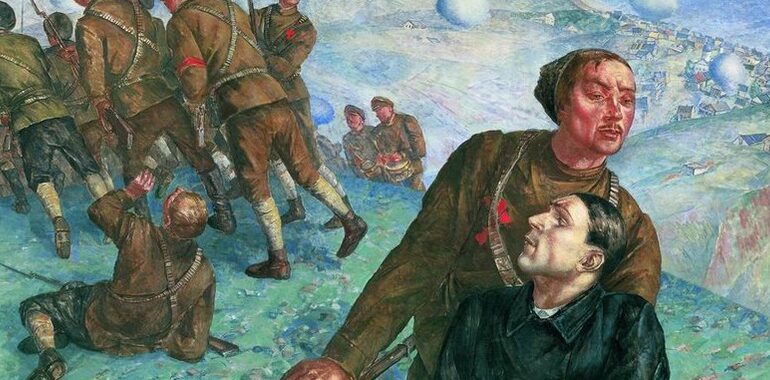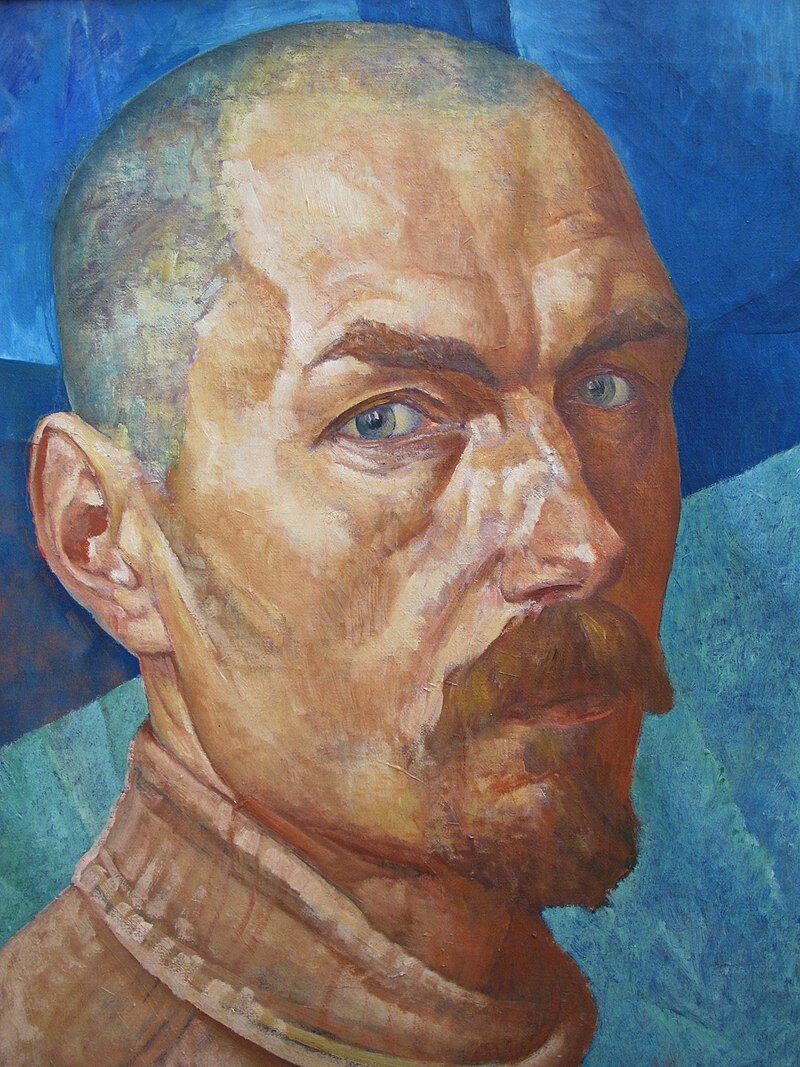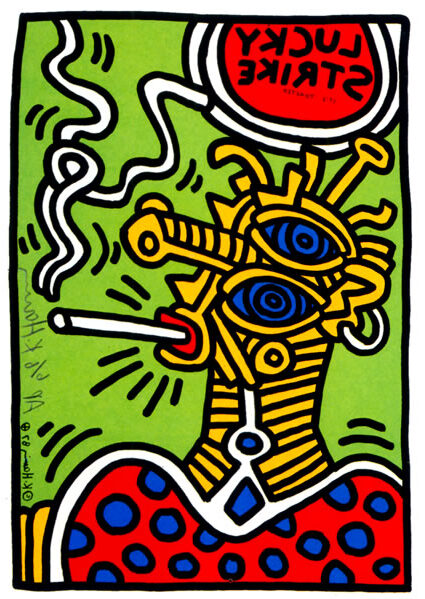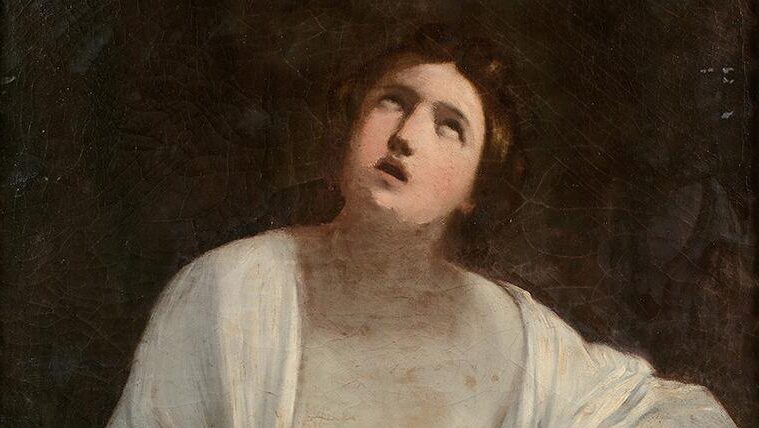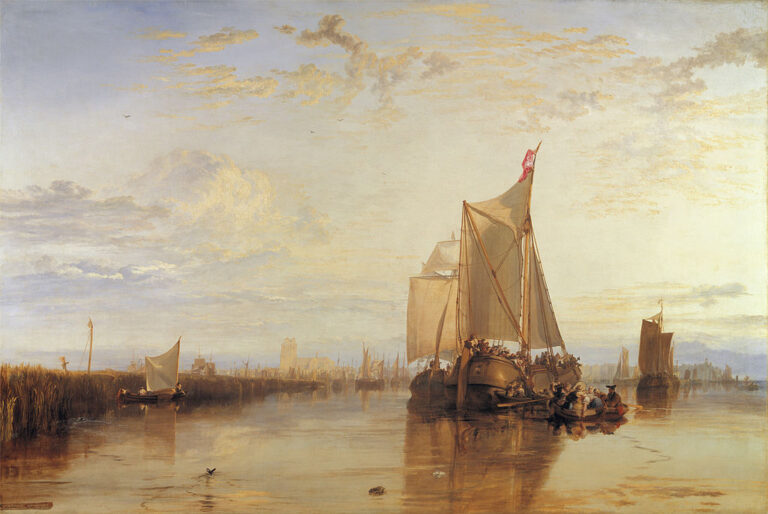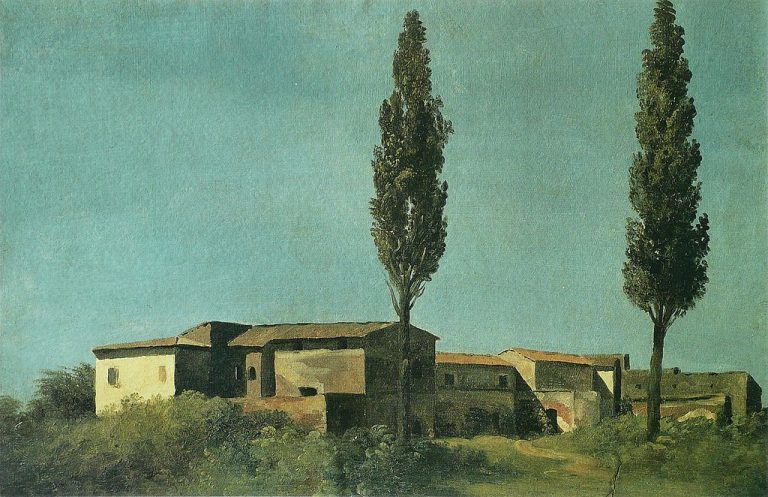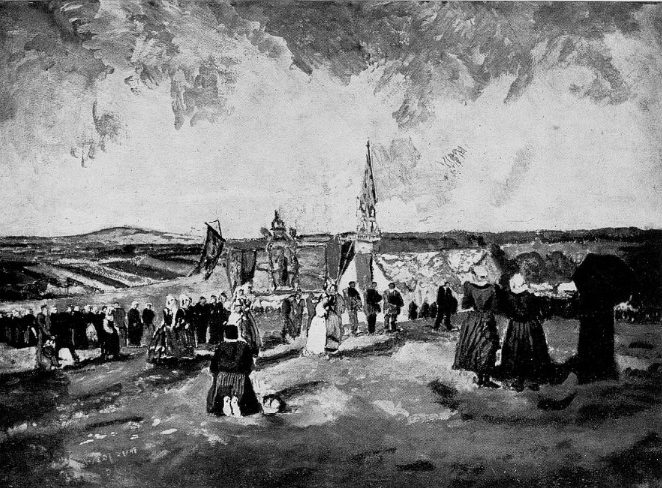Kuzma Petrov-Vodkin: Pioneering Russian Symbolist Painter of the Early 20th Century
Born: November 5, 1878, Khvalynsk, Saratov Governorate, Russian Empire
Death: February 15, 1939, Leningrad, Russian SFSR, Soviet Union
Art Movement: Symbolism
Nationality: Russian
Teachers: Valentin Serov, Isaak Levitan, and Konstantin Korovin
Institution: Saint Petersburg Stieglitz State Academy of Art and Design and Moscow School of Painting, Sculpture and Architecture
Kuzma Petrov-Vodkin: Pioneering Russian Symbolist Painter of the Early 20th Century
Life and Career of Kuzma Petrov-Vodkin
Kuzma Sergeyevich Petrov-Vodkin (1878-1939) developed a distinctive artistic approach. His career spanned a transformative period in Russian history, and his work reflected these changes through his unique visual language and philosophy.
Early Years and Education
Born in Khvalynsk, a small town in Saratov Oblast, Petrov-Vodkin was first exposed to art through lessons from a local sign maker. His humble beginnings did not prevent him from pursuing artistic education. His early talent attracted attention and support from local patrons.
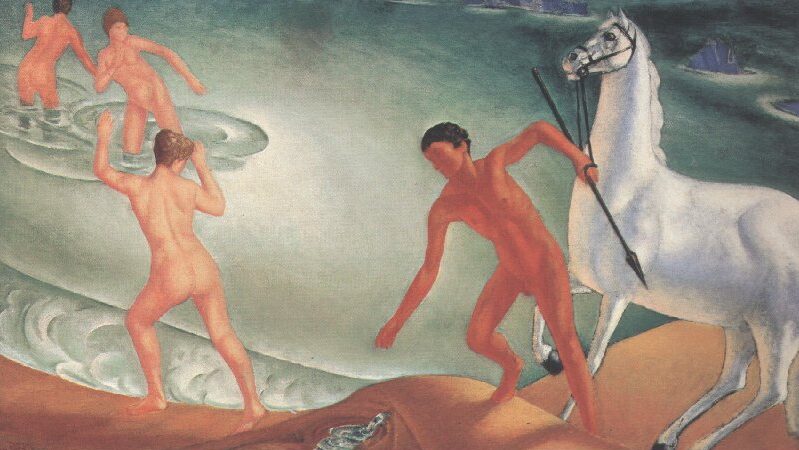
Thirsty Warrior, 1915, by Kuzma Petrov-Vodkin
Petrov-Vodkin expanded his artistic horizons by studying in Moscow and later Saint Petersburg. His formal training continued abroad, where he traveled to Munich and Paris to absorb European artistic influences. These formative experiences exposed him to various styles and techniques.
The combination of his Russian heritage and European education created a foundation for his distinctive style. He developed a unique perspective that would later characterize his most important works.
Major Works and Artistic Development
Petrov-Vodkin’s artistic language was deeply individual yet nationally spirited. He created an original approach to painting based on the curve of the globe, developing a special perspective system that became his trademark.
His palette was notably bold, featuring vibrant reds that became one of his recognizable characteristics. The 1912 painting “Bathing of a Red Horse” established him as a significant figure in Russian art. This work demonstrated his mastery of color and symbolic imagery.
During the revolutionary period, Petrov-Vodkin adapted his style while maintaining his artistic integrity. His work evolved to incorporate themes relevant to Soviet life, yet he preserved his distinctive perspective and color approach.
Besides painting, he was also a writer, expressing his artistic philosophy through literary works. His talents extended beyond visual arts, making him a multifaceted cultural figure.
Legacy and Influence on Russian Art
Petrov-Vodkin became one of the leading figures of early 20th-century Russian art. His work bridged traditional Russian iconographic techniques and modernist approaches, creating a unique position in art history.
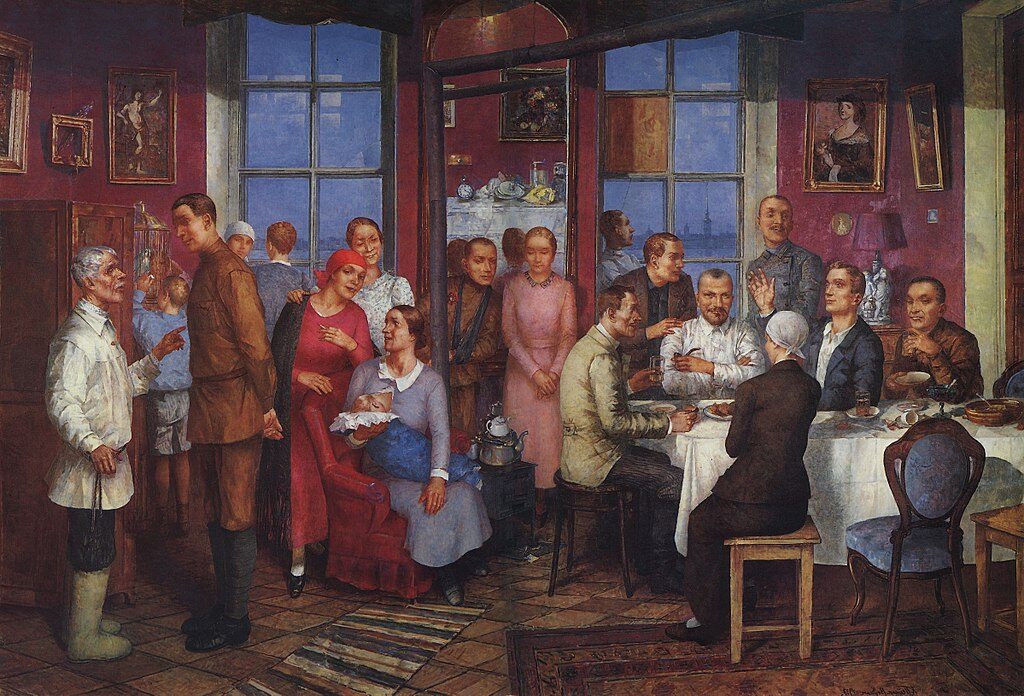
House-warming Party, 1937, by Kuzma Petrov-Vodkin
The Russian Museum holds significant collections of his work, preserving his legacy for future generations. His influence extended to many Soviet painters who admired his distinctive perspective system and color choices.
His ability to create art that was both deeply personal and nationally significant set him apart from his contemporaries. While many artists struggled with the transition to Soviet expectations, Petrov-Vodkin maintained artistic integrity while addressing new social realities.
His contributions to Russian and Soviet art continue to be studied and appreciated today. Art historians recognize him as a crucial figure who developed a truly national artistic language during a period of immense cultural transformation.
Artistic Style and Technique
Petrov-Vodkin developed a distinctive approach to painting that combined innovation in perspective with rich symbolism. His unique visual language emerged from both Russian spiritual traditions and modern European influences.
Spherical Perspective and Symbolism
Petrov-Vodkin’s most significant contribution to art was his development of “spherical perspective.” This technique presented the world as if viewed from a high point, revealing the curved surface of the earth. Unlike traditional linear perspective, this approach allowed multiple viewpoints in a single composition.
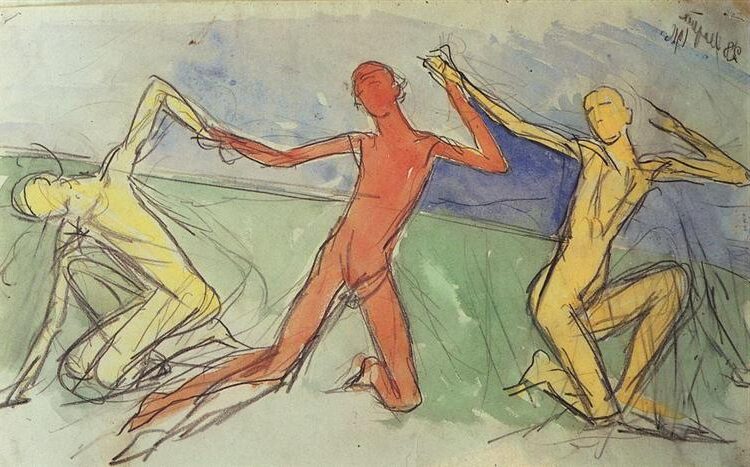
Boys, 1916, by Kuzma Petrov-Vodkin
The artist used this technique to create a sense of cosmic awareness in his work. Colors played a crucial symbolic role in his paintings, with red representing revolution and vitality. Blue symbolized spirituality and transcendence.
His masterpiece “Bathing of the Red Horse” (1912) exemplifies this approach. The painting features a nude boy on a bright red horse against a blue landscape, combining his spherical perspective with powerful symbolism of Russia’s emerging revolutionary spirit.
Portraits and Still Life Compositions
Petrov-Vodkin approached portraiture with a keen psychological insight. His portraits, including the famous “Portrait of Anna Akhmatova,” reveal subjects with directness and emotional depth. He typically positioned figures against simplified backgrounds with subtle color harmonies.
In his self-portraits, the artist often depicted himself with penetrating eyes and a serious expression, revealing his contemplative nature. These works show his technical skill in rendering facial features with precision.
His still life paintings stand out for their unique spatial arrangement. Objects appear to float slightly above surfaces, creating a sense of otherworldliness. Petrov-Vodkin frequently included symbolic elements like bread, fruit, and household items to represent Russian daily life.
Landscapes and Soviet Themed Works
Petrov-Vodkin’s landscapes depict the Russian countryside with his characteristic curved horizon lines and elevated viewpoint. He rendered rural scenes with simplified forms and bright, clear colors that capture the essence of the Russian landscape.

On the Line of Fire, 1916, by Kuzma Petrov-Vodkin
After the 1917 Revolution, his work evolved to include Soviet themes. He created paintings celebrating workers, soldiers, and mothers as symbols of the new society. “The Mother of God” (1915) represents his transition period, blending religious iconography with modern sensibilities.
His later landscapes incorporated industrial elements and urban scenes, reflecting Russia’s modernization. Despite embracing Soviet subjects, he maintained his distinctive style throughout this period, applying his spherical perspective to new themes while preserving his artistic integrity.
Notable Works and Exhibitions
Kuzma Petrov-Vodkin created several influential paintings that defined Russian art in the early 20th century. His distinctive style combined bold colors with unique perspective techniques that made his work immediately recognizable among his contemporaries.
Bathing of a Red Horse and Other Prominent Paintings
“Bathing of a Red Horse” (1912) stands as Petrov-Vodkin’s most iconic work. When exhibited at the World of Art Group exhibition in 1912, it instantly achieved fame and established his reputation. The painting features a young boy riding a bright red horse in water, using symbolic colors and simplified forms.
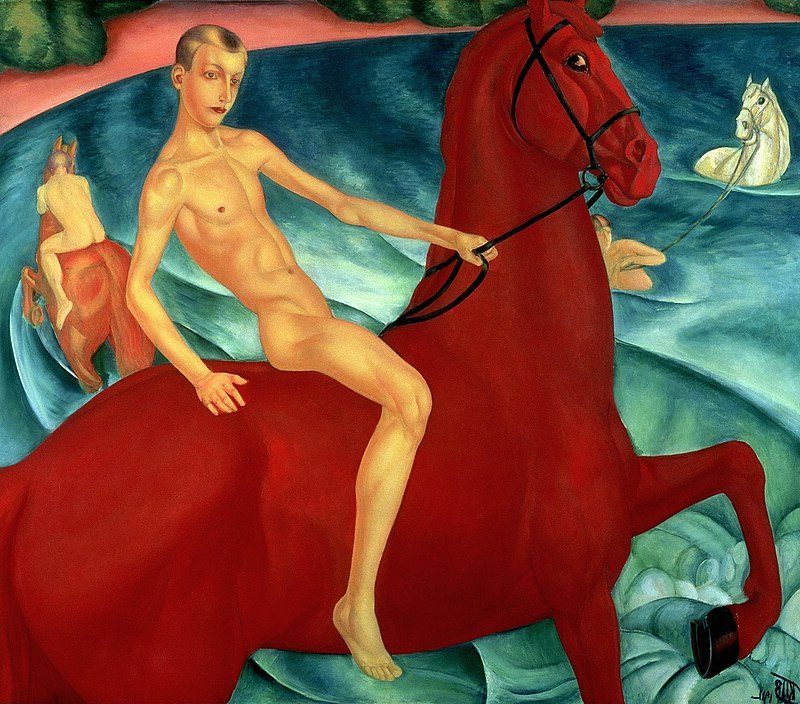
Bathing of a Red Horse, 1912 by Kuzma Petrov-Vodkin
Other significant works include “Petrograd Madonna,” “Motherhood,” and “On the Line of Fire,” which showcase his interest in maternal themes and Soviet life. “1919. Alarm” captures the tension of the revolutionary period with dramatic composition.
“Dream,” “Boys at Play,” and “Spring” demonstrate his skill with depicting everyday scenes through his distinctive lens. His 1918 painting “Morning” and the 1918 work “1918 in Petrograd” document life during a pivotal historical moment.
Public Collections and Art Sales
Petrov-Vodkin’s works are housed in prestigious museums across Russia and internationally. Many pieces reside in the State Russian Museum and the Tretyakov Gallery, where visitors can view his progression as an artist.
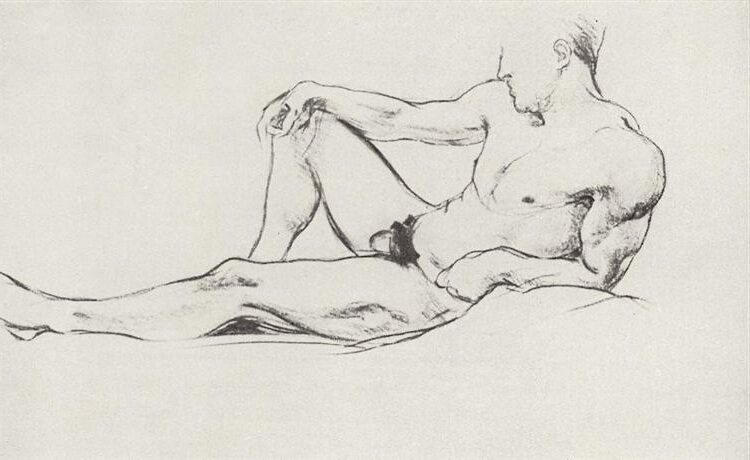
Sitter, 1906, by Kuzma Petrov-Vodkin
His 1936 painting “By the Shore of Lake Ilmen,” created during a summer trip near Veliky Novgorod, represents his later period. His still life paintings, including works featuring herring and violin, have gained attention at major auctions for their bold color schemes.
His paintings from Samarkand, created during his travels through Central Asia, demonstrate his interest in diverse cultural landscapes. These “Samarkandia” works show his ability to adapt his distinctive style to new environments and subjects.
Frequently Asked Questions
Kuzma Petrov-Vodkin developed a distinctive artistic language that combined technical innovation with deep Russian cultural influences. His unique approach to perspective, color theory, and symbolism created works that transcended traditional artistic boundaries.
What are the defining characteristics of Kuzma Petrov-Vodkin’s painting style?
Petrov-Vodkin’s style featured spherical perspective, a technique he called “planetary vision” where the Earth’s curve influenced composition. This created a distinctive tilted horizon in many of his works.
His palette centered around three primary colors: red, blue, and yellow. These bold color choices gave his paintings a vibrant, iconic quality that became instantly recognizable.
He combined elements of Russian icon painting with modernist approaches, creating a unique visual language that was both innovative and rooted in tradition.
Which historical events and eras influenced Petrov-Vodkin’s artwork?
The Russian Revolution of 1917 profoundly shaped Petrov-Vodkin’s artistic development and themes. His work reflected the social transformation and ideological shifts of this turbulent period.
Early 20th century art movements including Symbolism and Post-Impressionism influenced his style. He absorbed these Western influences while studying in Paris and Munich.
The spiritual traditions of Russian Orthodoxy and icon painting provided visual and conceptual foundations that remained visible throughout his career.
What are some of the most famous works created by Petrov-Vodkin, and what themes do they explore?
“Bathing of a Red Horse” (1912) stands as his most iconic work. The painting features a naked boy on a bright red horse, symbolizing purity, strength, and revolutionary spirit.
“1918 in Petrograd” (1920) captures the aftermath of revolution through a mother and child composition reminiscent of Madonna imagery but placed in contemporary context.
“Death of a Commissar” (1928) depicts a fallen revolutionary soldier, exploring themes of sacrifice and mortality while using his signature tilted perspective.
How did Kuzma Petrov-Vodkin contribute to the development of Russian art in the 20th century?
Petrov-Vodkin created a bridge between traditional Russian art forms and modernist techniques. His work helped establish a distinctly Russian modernism that wasn’t merely imported from Western Europe.
As a professor at the Leningrad Academy of Arts, he influenced generations of Soviet artists. His teaching emphasized fundamentals while encouraging innovation.
His theoretical writings on art expanded Russian aesthetic discourse. His book “Euclidean Space” outlined his unique approach to perspective and composition.
What was Petrov-Vodkin’s approach to color theory, and how did it manifest in his paintings?
Petrov-Vodkin developed a “three-color” theory centered on red, blue, and yellow. He believed these primary colors could express the full range of human emotion and experience.
Red held special significance in his work, representing vitality, revolution, and Russian identity. His mastery of red tones became one of his signature artistic elements.
He applied colors in smoothly modeled forms with little texture, creating a sense of clarity and balance. This approach enhanced the symbolic quality of his subjects.
Can you describe the influence of symbolism and mysticism in Petrov-Vodkin’s body of work?
Religious imagery appears throughout Petrov-Vodkin’s paintings. They are often reimagined in contemporary settings. Madonna-like mothers with children connect Russian Orthodox traditions with modern themes.
Cosmic and planetary elements reflect his interest in the relationship between humans and the universe. His “planetary perspective” wasn’t just technical but philosophical.
Horses frequently appear as symbolic creatures in his art. The red horse in particular represented spiritual strength, transformation, and the Russian soul during times of change.

